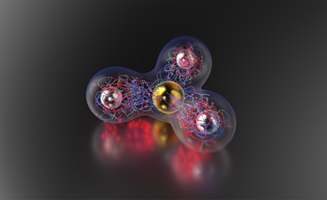 +565 975 658
+565 975 658
 info@premiumcoding.com
info@premiumcoding.com
 Monday - Friday, 8.00 - 20.00
Monday - Friday, 8.00 - 20.00
Science:New Route to Nanoscale Colloidal Molecules
Reported by Professor Zhihong Nie’s Group in Science
Molecules show properties that individual atoms do not have. Similarly, clusters of inorganic nanoparticles (NPs) with precise control exhibit synergistic properties that are often not attainable in their constituent nanoparticles. Assembly of inorganic nanoparticles into small clusters recapitulating the structure and symmetry of molecules (i.e., nanoscale colloidal molecules, CMs) has emerged as a promising strategy for generating functional nanostructures (Fig. 1).

Fig. 1 Schematic illustration of colloidal molecule AB3
Existing strategies for preparing CMs can be categorized into two main sets of concepts. (1) Packing isotropic particles under confinements. For micro-sized particles, it is ease to cluster in emulsion droplets with subsequent solvent evaporation. However, for nano-sized particles, the nonadditive interactions between nanosized particles limit the accurate control over clustering. (2) Symmetry-breaking of isotropic NPs, that is, functionalizing NPs with a discrete number of chemical patches. These approaches, especially, for nanometer-sized particles, are low yield and show a limited precision of CM fabrication.
Nie and coworkers report a conceptually new strategy, built on the mechanism of σ-bond formation by hybridization of atomic orbitals in molecules, to generate various nanoscale CMs at high yield. They show that spherical NPs uniformly coated with polymer ligands can interact directionally to form CMs in a self-limiting manner, without the need of site-specific surface functionalization of NPs. Two types of inorganic NPs (designated as NP-A and NP-B) are grafted with complementary block copolymer ligands to mimic atoms of two elements. The acid-base neutralization reaction between polymeric ligands triggers the directional bonding of NP-As and NP-Bs through the spatial reorganization of long, flexible polymer chains. The number of bonds formed in a CM are determined by the stoichiometry of the reaction, while the symmetry of a CM is governed by the Coulombic repulsion between the colloidal bonds containing charged groups. In stark contrast, for two NPs uniformly capping with small ligands, the reaction between them is limited to their contact zones, thus causing the formation of mixed clusters or aggregates with different sizes, rather than uniform CMs.
The report was published in Science with Dr. Chenglin Yi as first author, Professor Zhihong Nie and Professor Eugenia Kumacheva from University of Toronto (Canada) as the corresponding authors.
Yi, C.; Liu, H.; Zhang, S.; Yang, Y.; Zhang, Y.; Lu, Z.; Kumacheva, E.; # Nie, Z.,# Self-limiting directional nanoparticle bonding governed by reaction stoichiometry. Science 2020, 369 (6509), 1369-1374. Link:https://science.sciencemag.org/content/369/6509/1369
This work was highlighted by Professor Oleg Gang from University of Columbia (USA) in a Perspective paper on the same Volume of Science.
Get to know us better now!

Wechat:FDUMMers
Search!
Search across our website
Revenant @ 2018 by fudan | All Rights Reserved
Powered by Weicheng

